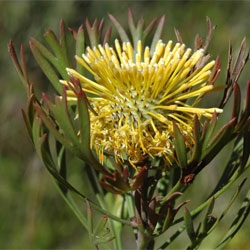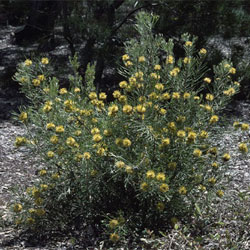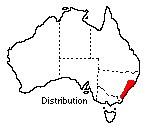Isopogon anemonifolius
 |
 |
 |
Drumsticks
Isopogon anemonifolius (Salisb.) Knight
The
Isopogons are related to Grevilleas and Banksias. They are ornate and curious
plants, rigid in growth with handsome foliage and rounded flower heads terminating
the branches. The common name, 'drumsticks', refers to the rounded fruits which
can be found on the bushes at all times of the year.

About 35 species are known, the majority occuring in Western Australia . The one
illustrated here, however, is native to the eastern States, its distribution extending
from coast to mountains. When exposed to sea winds it forms a dwarfed and tufty
ground cover and in more sheltered areas an upright shrub to 2 m high.
In Canberra it is hardy to frost and drought, remaining healthy for many vears with little attention, gradually becoming a heavy-limbed shrub about 2 m high. Adequate water, however, ensures the best condition. A group of vigorous young plants around 1 m high may show an interesting variety of forms. All tend to be bushy, covering the ground well - some branches partly prostrate and others upright.
Single specimens are attractive in a border or in public places; groups may be set in gravel or tan bark or among large rocks as this species will stand exposure. The soft yellow flowers are prominently displayed at the ends of branches.
The
divided leaves, growing stiffly upwards are tough and resistant to blemishes
of all kinds. From autumn to spring they are tinged purple in pleasant contrast
to the grey conelike seed heads. Depending on water supply the compact flower
heads open between October and January although November is generally the best
month. In a dry year the soft yellow flowers are smaller and not as showy.
Seed is plentiful, falling easily from the 'cones' when they are left to open in a bag in a warm place. Young plants raised from seed can be obtained from some nurseries dealing in native plants, and a good time to establish them is from late August to mid September or in the autumn. Most well-drained soils seem suitable; coarse sand should be added to very heavy soil and lime would not be favourable.
With attention to watering, new plants grow steadily and are best left to shape naturally without pruning. No significant pests or diseases have been noticed. Simple arrangements of foliage stems, with or without flowers and 'cones', are very effective and long-lasting in water.
Based on text by Irene Beeton (1971)
| Name meaning: Isopogon anemonifolius
Isopogon - from two Greek words meaning 'equal' and 'beard', alluding to the hairy fruits of some species; anemonifolius - with leaves like those of some Anemones |
![An Australian Government Initiative [logo]](/images/austgovt_brown_90px.gif)

